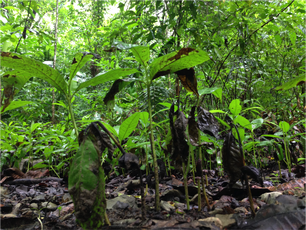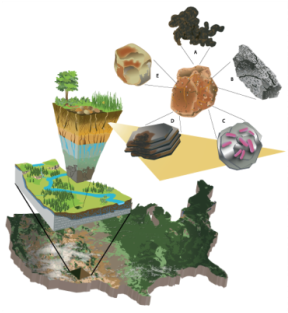Ecosystem response to climate warming in Northern Andean Alpine Páramo
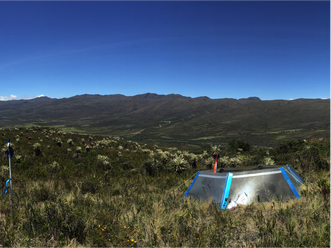
The ecology of the Colombian Andes Mountains is threatened by changing climate. Local development, food security, and water quality for Colombian cities depends upon understanding plant and soil microbial responses that influence these ecosystem services. Climatic factors that favored the accumulation of large carbon stores in Andean grasslands (páramo) are changing. As a result, páramo could play a major role in driving climate feedbacks. In collaboration with Dr. Eloisa Lasso's EcoFiv Research Group at the Universidad de los Andes, Bototá, Colombia, we are investigating how soil microbes and plants together change ecosystem carbon storage in response to warming. This research represents one of the first efforts to monitor the effects of climate change on soil microbiome assembly and influences on ecosystem carbon balance in Colombian páramo using an experimental warming approach.
Microbial controls of tropical plant community diversity
|
Plant-microbe interactions are important but cryptic components of how communities and ecosystems function and respond to change. Fundamental information such as the natural history and biogeography of many microbial genotypes are unknown, and the complexity of microbial communities often results in the distillation of their functions into inelegantly simplified emergent processes. We do know that parasitic and mutualistic plant-microbe associations can change the competitive interactions among plant species, potentially influencing plant biodiversity by exerting strong control over the establishment of seedlings in a community. These plant-microbe interactions may be especially important in tropical forests, which are critical reservoirs of biodiversity increasingly threatened by changing climate and land conversion. We have found that fungi can mediate the outcomes of interspecific competition among tropical forest seedlings in direct and indirect ways.
|
Soil microbial impacts on dryland native plant revegetation
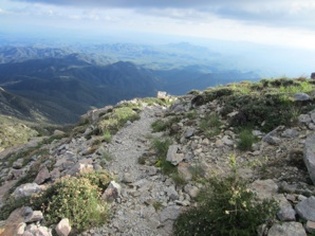 View from Mt. Wrightson
View from Mt. Wrightson
Disturbance and non-native plant invasions are widespread and increasing in the arid Southwestern U.S., leading to increases in fire return intervals and erosion that typically result in losses of native plant biodiversity. Soil biota, including bacteria, archaea, and fungi, form the foundational structure of plant community dynamics and could be used as early warning indicators of changes in ecosystem resilience and impending vegetative shifts from disturbance and plant invasions. Preliminary results show that differences in soil biota between native and non-native plant communities are substantive, apparent, and affected by disturbance, but an improved mechanistic understanding is needed to accurately predict impacts of specific changes in soil biota on plant community and soil aggregate stability. Identifying differences in key microbial taxa or functional groups between disturbed and undisturbed native communities can be translated into risk parameters and allow more effective invasion prevention and native reclamation efforts.
Geomicrobiology and Biogeochemistry of the Critical Zone
|
The Critical Zone (CZ) is the semi-permeable membrane on the Earth's surface that extends from bedrock to the tops of trees. Microbes drive Earth's biogeochemical cycles and play a critical role in ecosystem services including nutrient cycling, carbon stabilization, carbon flow and weathering. Our Critical Zone Thematic Cluster GeoMicro is developing a predictive understanding of how the interaction among soil microbes, roots, mineral composition, and soil organic matter drives Critical Zone biogeochemistry and soil formation. Understanding linkages between microbial communities and observed biogeochemistry is assessed by coupling molecular and functional assays with soil physical and biogeochemical analysis to build a better predictive understanding between community structure and soil processes in watersheds across the U.S. |
Past Projects
Microbial response to fire in high elevation forests
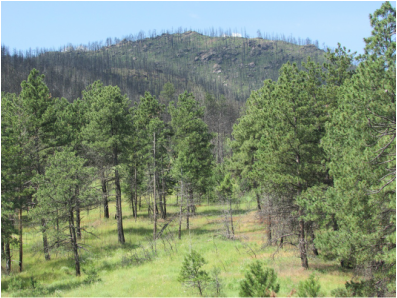
Fires have long-term effects on ecosystem carbon cycling through their immediate influence on the plant and microbial community and the longer-term influence on litter and organic soil layers that supply slow-release nutrients to the soil microbial community. The influence of fires on the soil microbial community can last for decades and alters the release of carbon from the forest through soil respiration. Mechanisms that contribute to the recovery of the microbial community and the long-term influence to soil respiration are not yet well characterized. In collaboration with Dave Moore, the aim of this work is to determine whether patterns of increasing microbial community complexity are present in forest soils along a post-fire chronosequence in the Rocky Mountains, and to determine if the variability in soil respiration is associated with the recovery of the microbial community.
Diversity and phenotypic effects of bacterial endosymbionts of fungi
The vast majority of plants on earth harbor fungal endophytes within their healthy leaves. These endophytes enhance plant physiology and defense against pathogens, and shape the productivity of crops and wild plants. It was recently discovered that endophytes harbor their own endosymbionts -- endosymbiotic bacteria that live within fungal tissues (endohyphal bacteria). Fungal traits such as stress tolerance and cellulose degradation are enhanced by bacterial symbionts, suggesting an important, yet previously unknown, role in structuring beneficial relationships between fungi and their host plants. We are testing the hypothesis that bacterial endosymbionts influence the fungal phenotype and ultimately, the outcome of plant-fungus interactions. With Betsy Arnold and Dave Baltrus we're part of a team to examine the genomic architecture, phenotypic effects, and ecological impacts of these intriguing symbionts. Work in this area is currently led by PhD students Justin Shaffer and Sarah Araldi. NSF IOS: Bacterial Controls of Endophyte Phenotypes: an Unexplored Dimension of Diverse Plant-fungal Symbioses
Proudly powered by Weebly
